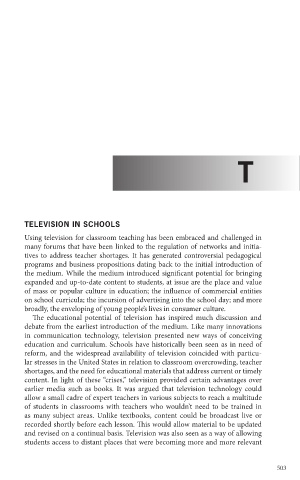Page 524 - Battleground The Media Volume 1 and 2
P. 524
t
teleVision in sChools
Using television for classroom teaching has been embraced and challenged in
many forums that have been linked to the regulation of networks and initia-
tives to address teacher shortages. It has generated controversial pedagogical
programs and business propositions dating back to the initial introduction of
the medium. While the medium introduced significant potential for bringing
expanded and up-to-date content to students, at issue are the place and value
of mass or popular culture in education; the influence of commercial entities
on school curricula; the incursion of advertising into the school day; and more
broadly, the enveloping of young people’s lives in consumer culture.
The educational potential of television has inspired much discussion and
debate from the earliest introduction of the medium. Like many innovations
in communication technology, television presented new ways of conceiving
education and curriculum. Schools have historically been seen as in need of
reform, and the widespread availability of television coincided with particu-
lar stresses in the United States in relation to classroom overcrowding, teacher
shortages, and the need for educational materials that address current or timely
content. In light of these “crises,” television provided certain advantages over
earlier media such as books. It was argued that television technology could
allow a small cadre of expert teachers in various subjects to reach a multitude
of students in classrooms with teachers who wouldn’t need to be trained in
as many subject areas. Unlike textbooks, content could be broadcast live or
recorded shortly before each lesson. This would allow material to be updated
and revised on a continual basis. Television was also seen as a way of allowing
students access to distant places that were becoming more and more relevant
503

